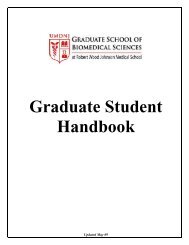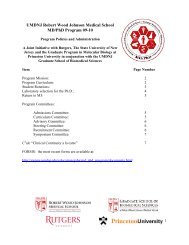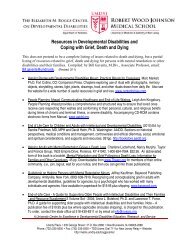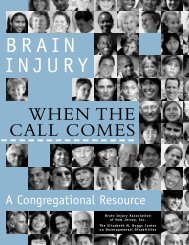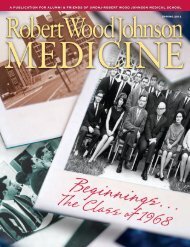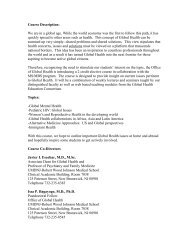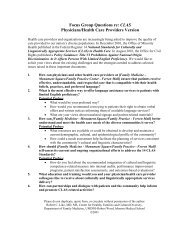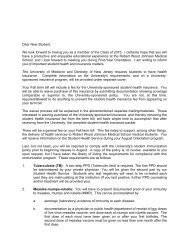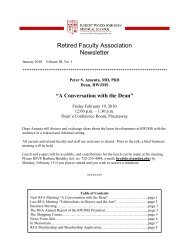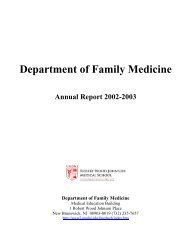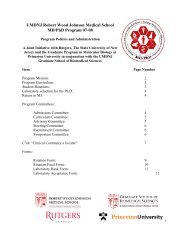Robert Wood Johnson Medicine • Spring 2011 • Population Science
Robert Wood Johnson Medicine • Spring 2011 • Population Science
Robert Wood Johnson Medicine • Spring 2011 • Population Science
You also want an ePaper? Increase the reach of your titles
YUMPU automatically turns print PDFs into web optimized ePapers that Google loves.
our goal is to provide comprehensive<br />
cancer care and improved outcomes<br />
for patients with cancer.”<br />
Translational <strong>Science</strong><br />
“<br />
The Cancer Institute is the ideal<br />
hub for the Cancer Prevention<br />
and Control Program,” says<br />
Dr. DiPaola. Every member of CINJ<br />
conducts research, but it is also a center<br />
for patient care, where the emphasis<br />
is on translational science — discoveries<br />
that will improve clinical care<br />
and outcomes for patients with cancer.<br />
“It is gratifying to work in a place<br />
where your research can directly affect<br />
clinical prevention and treatment,”<br />
says epidemiologist Grace Lu-Yao,<br />
PhD, MPH, professor of medicine. “In<br />
research, it’s always a strength to<br />
include doctors who treat patients and<br />
know the issues. They know the questions<br />
we need to ask to make our work<br />
clinically relevant.”<br />
Following is a<br />
representative<br />
sampling of the<br />
population-based studies led by<br />
members of CINJ who are also<br />
members of the Cancer Prevention<br />
and Control Program:<br />
<strong>•</strong> “The Jersey Girl Study”:<br />
An evaluation of environmental<br />
factors, including nutrition, that<br />
affect early onset of puberty, a<br />
possible risk factor of breast cancer<br />
(Elisa V. Bandera, MD, PhD,<br />
associate professor of surgery)<br />
<strong>•</strong> A study of the association between<br />
increased physical activity and<br />
greater quality of life in patients who<br />
have undergone surgery for early-<br />
Dr. Lu-Yao, a member of the Cancer<br />
Prevention and Control Program,<br />
has published several studies that<br />
reflect the value of “watchful waiting”<br />
for men diagnosed with low-risk<br />
prostate cancer. Most recently, she<br />
found that a high proportion of men<br />
with that diagnosis still choose radical<br />
treatment — most often surgery or<br />
radiation — when it may not be necessary.<br />
In continuing research, Dr. Lu-<br />
Yao will study the decision-making<br />
process that leads to a patient’s choice<br />
of aggressive treatment for low-risk<br />
disease. “This is especially concerning<br />
for older men,” she says, “as previous<br />
studies done by our team show excellent<br />
disease-specific survival for men<br />
with low-risk cancer following conservative<br />
management.”<br />
Dealing with prostate cancer benefits<br />
from a multi-disciplinary approach,<br />
including the psychosocial reasons for<br />
choosing a form of treatment. “Perhaps<br />
it is because cancer is viewed as<br />
CINJ Researchers Apply <strong>Population</strong> <strong>Science</strong> Methodologies<br />
stage lung cancer (Elliot J. Coups,<br />
PhD, associate professor of<br />
medicine)<br />
<strong>•</strong> Investigation of possible factors<br />
underlying the finding that breast<br />
cancer is more aggressive and more<br />
lethal for African American women<br />
than for white women (linked<br />
studies by Dr. Bandera and Kitaw<br />
Demissie, MD, PhD, MPH, associate<br />
professor and chair, Department of<br />
Epidemiology, and director, Institute<br />
for the Elimination of Health<br />
Disparities, UMDNJ-School of Public<br />
Health)<br />
<strong>•</strong> Development of an intervention to<br />
increase cancer screening in obese<br />
patients by improving patient<br />
an enemy to be fought.<br />
Men who have initially<br />
chosen the ‘watchful<br />
waiting’ approach may be<br />
influenced by a cancer survivor,<br />
friend, or family member who<br />
presses them to get treatment,” says<br />
Dr. Lu-Yao. “It’s hard for patients to<br />
choose among available treatments,<br />
but patient education using the facts<br />
derived from a population science approach<br />
will help them to weigh the<br />
risks and benefits of the treatments<br />
and understand that watchful waiting,<br />
with monitoring, may be the most sensible<br />
choice.”<br />
“Many people think of population<br />
science as a dry laboratory science, but<br />
it is the cornerstone of all medicine,<br />
leading to disease prevention and<br />
increased survival among people of all<br />
ages,” says epidemiologist and former<br />
physician Kitaw Demissie, MD, PhD,<br />
MPH, associate professor and chair,<br />
Department of Epidemiology, and<br />
navigation in primary care practices<br />
(Jeanne M. Ferrante, MD, associate<br />
professor of family medicine and<br />
community health)<br />
<strong>•</strong> Identification of small but common<br />
genetic changes that may have<br />
significant implications for the<br />
identification of those at risk for<br />
early breast cancer and the treatment<br />
of those at risk of relapse (Kim M.<br />
Hirshfield, PhD, MD ’99, assistant<br />
professor of medicine)<br />
<strong>•</strong> A study of smokers of mentholated<br />
cigarettes to determine the role of<br />
menthol in increased tobacco addiction<br />
and its interference with cessation<br />
attempts (Jill M. Williams, MD,<br />
associate professor of psychiatry)<br />
<strong>Robert</strong> <strong>Wood</strong> <strong>Johnson</strong> ■ MEDICINE 31



